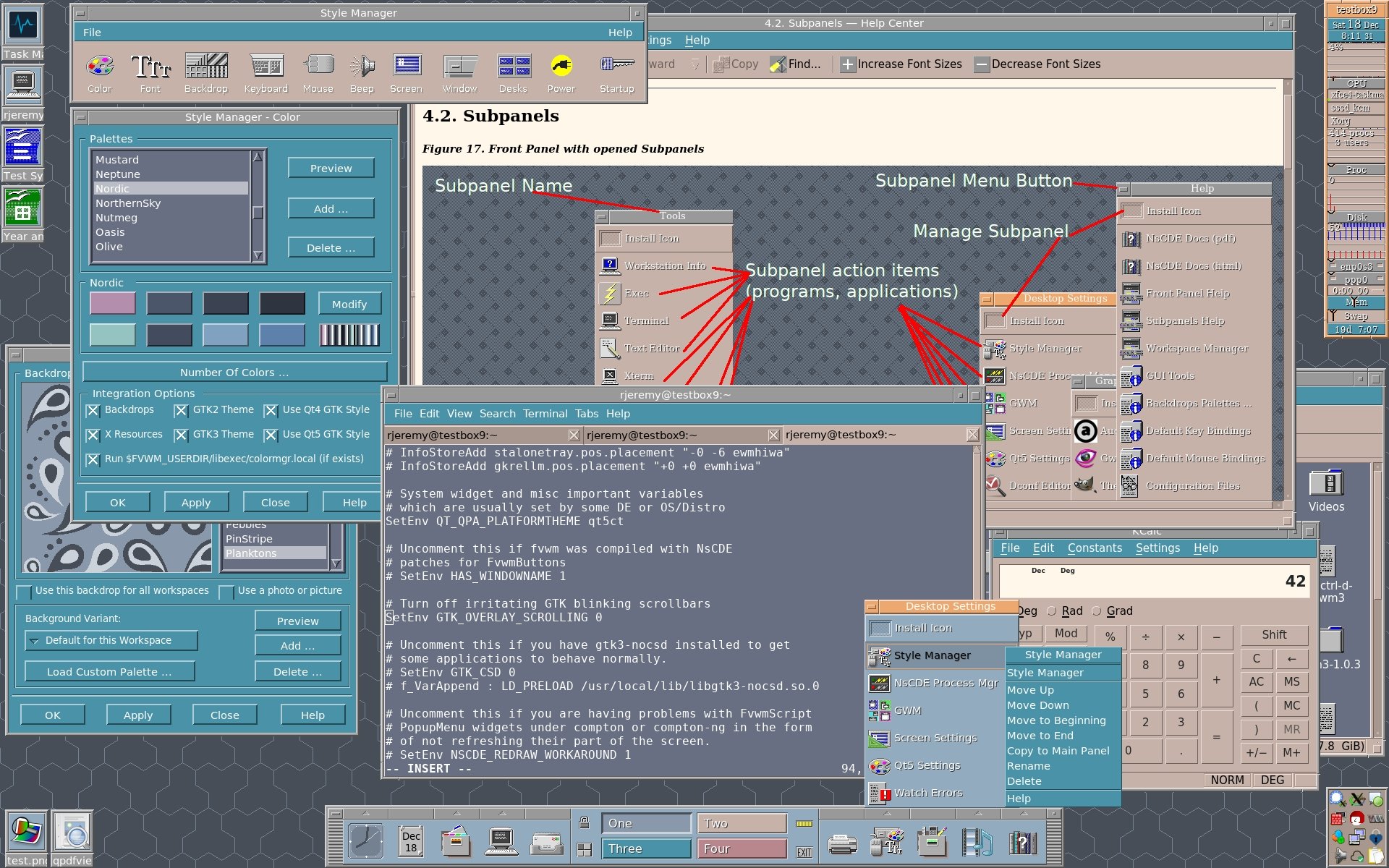Seamless adaption to higher DPI when I work remotely on my work Windows machine. The RDP clients will just expand the desktop and everything is very small when I WFH. mstsc will change the size of everything but legacy apps according to the DPI of the display.
Did you set the DPI in your RDP client? I had this too with my Windows VM, and it would just reset whenever I’d change it in Windows. Changed it in the FreeRDP flags and now the scale is correct, Windows applies 150% whenever I RDP in.
reboots after every update
Coherent theming, although you’ve hardly had that since Windows 98.
I’ve applied themes to make Xaw, Qt, and GTK software more Motif-like, but the GTK ones seem spotty and the Qt theme doesn’t work for Qt6, and fonts are inconsistent.
If you want a coherent motif-ish theme, NsCDE is amazing. It themes like everything in the world and is honestly like the most consistent looking desktop I’ve ever used
https://github.com/NsCDE/NsCDE/

I tried pulling in the theming from there, and while it works miracles, I still want to do the three-headed dragon meme:
- Real Motif apps
- Qt5 apps (where there’s a Motif-like theme baked in)
- GTK apps, which don’t honour the same fonts and the theme is far more divergent from the “real deal”
There are a few other “Solaris 9” and “Perl Tk” lookalike themes that also come close, but they’re all sabotaged by GTK’s lack of bitmap font support (The old bitmap Helvetica is my go-to UI font)
Wait Linux doesn’t have this??!! Why the fuck not?
It works fine with my AMD GPU. Good luck with NVIDIA though.
See with my AMD card it never worked but maybe it was just a driver bug with the rx 5500
The carelessness. Mac OS is far from perfect, but it just happily chugs along. Linux often creates problems by just existing for too long. It’s gotten much much better, but it’s still not good.
I believe that’s due to package drift.
Every system starts with the same packages, but due to upgrading or adding/ removing stuff, you slowly drift away from the starting point, which makes it truly “your own”. But this also introduces bugs that aren’t reproducible.
I especially noticed it with KDE. Every time I installed a new distro or configuration, it worked fine, but after a few months, the bugs and crashes got more and more.
Since I installed Fedora Atomic (the “immutable” variant, e.g. Silverblue), everything just works. It’s extremely comfortable and just exists, so I can run my apps. When you upgrade the system, you don’t just download one package and install it, you apply it to the whole OS and then basically have the same install as all the thousands of other users out there, which makes it reproducible.
Maybe that’s something for you? You can check out Aurora, Bazzite or uBlue in general.
I already thought about that, but never really could justify switching.
I would argue, though, that it’s not customization, but rather packages themselves changing over time and sometimes just break.
And sometimes you have crap like a full boot partition, because apt decided to keep all Linux versions for some reason.
Not a darn thing.
Honestly there too. I dual boot between windows and linux for some work stuff, and on windows I find myself thinking “how do people tolerate this shit?”. That’s often when deleting a large folder or uncompressing an archive :)
What’s so hilarious to me are the animations that go along with deleting (or moving) a large folder. The old animation was just a file flapping its way from one destination to another. When Windows 7 came out, there were zooming icons with lens flares! I was like “What’s next? A dancing frog?”
I don’t necessarily miss it, but the primary reason I can’t use Linux as a daily driver at work is because our VPN doesn’t work on Linux. So I’d say that. Stupid as fuck that our IT department uses Linux for all of our servers but makes us run Windows.
Do you know what vpn they configurrd that linux cam’t connect to it?
Just curious
It’s a Cisco AnyConnect doodad, but it checks your computer for compliance first before allowing you to connect, so beyond spoofing a valid system, I’m out of luck. And I’m not about to lose my job due to spoofing a windows box, haha.
I’ve successfully used Anyconnect for years in a dedicated Windows VM. However I only used it to connect to a Remote Desktop so performance was a non-issue.
The key there is the check for compliance. They probably have an MDM or enterprise thing that ensures only approved apps are installed and all, and only then it issues a short lived certificate used to log into stuff.
The protocol itself is likely supported by OpenConnect but you’d have to actively circumvent IT’s systems to make it work and thus a very bad idea.
I had the same issue and use this without any issues: https://github.com/yuezk/GlobalProtect-openconnect
Well, I’m am confident it would run on my machine, but how would it do in reporting machine compliance? Because that’s the part I can’t get past.
I missed Odin 3 for a few years until I switched to Graphene and never looked back. In tried the FOSS package it didn’t work for me and the documentation was beyond my skills at the time.
I miss the stupid people comradery, sometimes. People act funny when you’re a normal stupid person and use Linux without the hoodie and a Matrix screen saver.
Keypirinha. Krunner is good but not that good.
Sharex. Spectacle is fine but not perfect.
Really good image noise reduction software.
That’s pretty much the only thing I miss, and I don’t miss it enough to suffer through Windows
For microphones?
Image noise. For photography
Images of microphones?
I bought myself a copy of Neat Image a few weeks ago for noise reduction, and it works really well on Windows. I haven’t had a chance to test the Linux version yet. I think it’s proprietary, but like you say, there’s not much else out there.
There’s a free demo if you want to try it
Plus software like that probably runs great in wine or proton or whatever the new thing is
Unfortunately not. It won’t run under wine or the like. Even VMs are painful, because it needs GPU pass through to work, which requires a second dedicated video card
Shared memory is basically using your normal RAM as swapspace for your GPU.
From what I read online this only works for integrated cards?
isn’t the primary vram for integrated cards just the system ram?
When I switched, about 23 years ago, I missed Moray - the modeller for POVRay. Now I miss nothing.
I switched in 2005, I miss being in my 40’s. 😋
Great comment.
I switched full time in 2010, but was mostly using Linux from 2008…I don’t really miss my 20’s, maybe the physical side of being sub-30.
You’re still cool as heck
Thanks, you just made my day. 😀
I switched at about the same time. I miss being in my twenties. 😋
Windows/Games working out of the box with zero tinkering.
No amoint of proton or other software works as well for me as it seemingly does for othersI agree with that
Except for online games, pretty much all the other games work without any tinkering for me since at least a year
Glad it works for you, I have the exact opposite exepeirenxe with most games (I rarely play online).
To the point I sometimes feel like I’m taking crazypulls
Are you using Steam, or games from another service? I’ve only found 1 or 2 things that didn’t work immediately on Steam, but I have an absolute hell of a time getting anything off Steam to run, it’s like pulling teeth. Especially older Windows games; they’re just a non-starter most of the time.
I just use a single Bottle’s bottle to install a bunch of off-Steam games. Contains many older windows dependencies; you have to install them yourself but they are found within the bottle’s settings.
I remember trying to get Sims 3 working for my partner, it had all sorts of missing textures, kept crashing and had poor performance. Turns out you need a 4gb patch?? made from the community? Decided to toss it in my bottle and it works flawlessly. Have not tried dos games but may be worth a shot.
From steam, to lutris to base wine to he to trying a couple back cause nothing else worked.
Saw it all, did it all and I hazard a guess I soon will see it all againIs it possibly your distro? Maybe share what you’re using, and see if others are having different luck with it?
I even wonder what games are u talking about ,wanna try to run on my machine
The one who probably provided me the most trouble and headache over the years is my favourite anno, 1404 history edition
I tried it running with portproton with pirated version works smooth no tinkering.Running on arch linux with hybrid graphics on nvidia mx940.
Wow,i even got downvoted.
I usually check the proton DB website, to read the comments and see what people do to fix games and software.
Just recently I used it to get old CAD software to run, had to lower the proton version to 6 or something and it worked.
from all the times i tried to use protondb for help, for me, i can count the times it actually did on one hand
Ae you sure Linux doesn’t support shared GPU memory? I mean if you had an integrated GPU with no strictly reserved memory which is fairly common the GPU has to share the memory with rest of the system. There’s no other way for it to even function.
Pretty “swapping” VRAM to system RAM has been supported for a very long time too. My GPUs can use up to 16GB each of system memory (AMD), and I’d be really shocked if NVIDIA’s proprietary driver doesn’t either because I’m sure the AI workloads need it.
Of course the Steam Deck is a prime example of dynamic CPU/GPU memory allocation as well.
If you’re running this GPU under Windows, it’s fine. But good luck doing that under Linux.
https://forums.developer.nvidia.com/t/non-existent-shared-vram-on-nvidia-linux-drivers/260304?page=2
Fair enough, another one for the NVIDIA woes list!






















